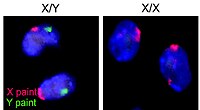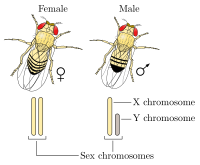| Part of a series on |
| Sex |
|---|
 |
| Biological terms |
| Sexual reproduction |
| Sexuality |
| Sexual system |

The XY sex-determination system is a sex-determination system present in many mammals, including humans, some insects (Drosophila), some snakes, some fish (guppies), and some plants (Ginkgo tree).
In this system, the sex of an individual usually is determined by a pair of sex chromosomes. Typically, females have two of the same kind of sex chromosome (XX), and are called the homogametic sex. Males typically have two different kinds of sex chromosomes (XY), and are called the heterogametic sex.[1] In humans, the presence of the Y chromosome is responsible for triggering male development; in the absence of the Y chromosome, the fetus will undergo female development, except with various exceptions such as individuals with Swyer syndrome, that have XY chromosomes and a female phenotype, and de la Chapelle Syndrome, that have XX chromosomes and a male phenotype, however these exceptions are rare. In some instances, a seemingly normal female with a vagina, cervix, and ovaries has XY chromosomes, but the SRY gene has been shut down.[2][3] In most species with XY sex determination, an organism must have at least one X chromosome in order to survive.[4][5]
The XY system contrasts in several ways with the ZW sex-determination system found in birds, some insects, many reptiles, and various other animals, in which the heterogametic sex is female.
A temperature-dependent sex determination system is found in some reptiles and fish.
- ^ Hake L, O'Connor C (2008). "Genetic Mechanisms of Sex Determination". Nature Education. Learn Science at Scitable. 1 (1): 25. Archived from the original on 2021-04-28.
- ^ Callaway E (9 April 2009). "Girl with Y chromosome sheds light on maleness". New Scientist. Retrieved 2023-02-22.
- ^ Biason-Lauber A, Konrad D, Meyer M, DeBeaufort C, Schoenle EJ (May 2009). "Ovaries and female phenotype in a girl with 46,XY karyotype and mutations in the CBX2 gene". American Journal of Human Genetics. 84 (5): 658–663. doi:10.1016/j.ajhg.2009.03.016. PMC 2680992. PMID 19361780.
- ^ Sherwood S (16 January 2014). "Can a Zygote Survive Without an X Sex Chromosome?". Education - Seattle PI. Retrieved 2020-11-08.
- ^ Sherwood S (April 25, 2017). "What Occurs When the Zygote Has One Fewer Chromosome than Usual?". Sciencing. Retrieved 2021-04-29.

